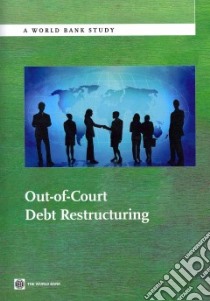Out-of-court Debt Restructuring - 9780821389836
Un libro in lingua di Garrido Jose M. edito da World Bank, 2012
- € 19.10
- Il prezzo è variabile in funzione del cambio della valuta d’origine
This study provides a conceptual framework for the analysis of the questions of out-of-court debt restructuring from a policy-oriented perspective. The starting point of the analysis is given by the World Bank Principles for Effective Insolvency and Creditor Rights Systems.The study offers an overview of out-of-court restructuring, which is not seen as fundamentally opposed to formal insolvency procedures. Actually, the study contemplates different restructuring techniques as forming a continuum to the treatment of financial difficulties. Thus, from the purely contractual – or informal – arrangements for debt rescheduling between the debtor and its creditors, to the fully formal reorganization or liquidation procedures, there are numerous intermediate solutions. In the study, these solutions are identified by the terms of enhanced procedures –where the contractual arrangements are supported by norms or principles for workouts; and hybrid procedures –where the contractual arrangements are supported by the intervention of the courts or an administrative authority. The study discusses the advantages and disadvantages of all the debt restructuring techniques, and concludes, in this regard, that a legal system may contain a number of options – a menu – that can cover different sets of circumstances. In the end, the law may offer a toolbox with very different instruments that the parties may use depending on the specific facts of the case.A substantial part of the study is devoted to the analysis of the enabling regulatory environment for out-of-court restructuring. It is evident that debt restructuring does not operate in a vacuum: in fact, the general legal system influences and to a certain extent determines the possibilities for debt restructuring in any given jurisdiction. The study provides a checklist that can be used to examine the features of a legal system that bear a direct influence on debt restructuring activities.The different characteristics of informal restructurings, and of enhanced and hybrid debt restructurings are covered by the study. The different approaches to debt restructuring aim at combining the advantages of an informal approach with the advantages of formal procedures: especially, the existence of a moratorium on creditor actions and the binding effects of creditor agreements concluded within the insolvency process.
Informazioni bibliografiche
- Titolo del Libro in lingua: Out-of-court Debt Restructuring
- Lingua: English
- Autore: Garrido Jose M.
- Editore: World Bank
- Collana: World Bank (Paperback)
- Data di Pubblicazione: 12 Gennaio '12
- Genere: LAW
- Argomenti : Loan workouts Congresses Bankruptcy Congresses Debtor and creditor Congresses
- EAN-13: 9780821389836


